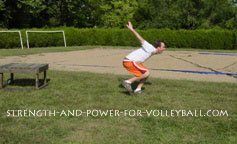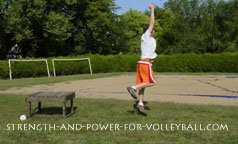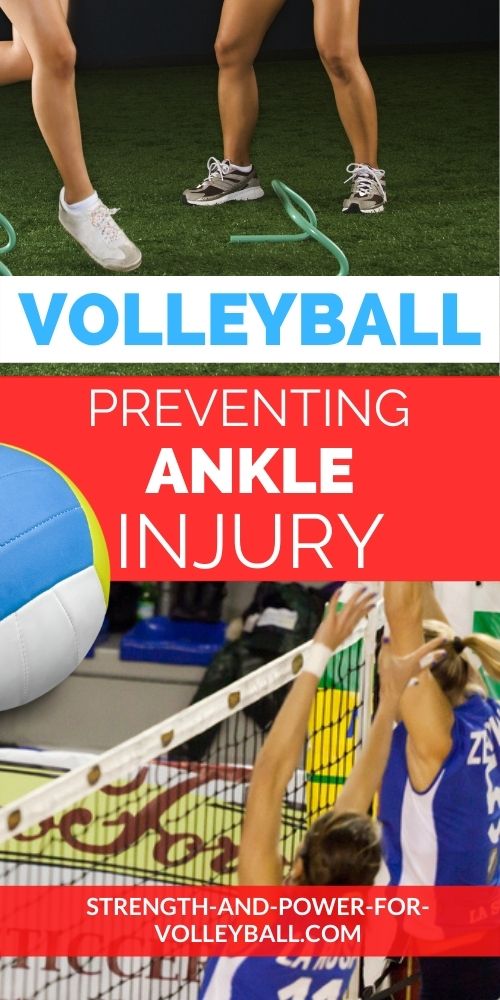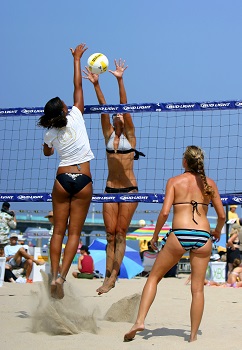- Home
- Smarter Training
- volleyball ankle supports
Volleyball Ankle Supports
Strengthen and Protect from Injury
Do the benefits of volleyball ankle supports outweigh the expense? Many studies have compared taping versus bracing.
Many studies found it was difficult controlling all of the variables associated with ankle injuries (eg, playing surface, shoe wear, individual inherent stability, intensity of competition on both a team and individual level).
Most studies have shown that braces are slightly more effective than taping but that both are better than no support.
One interesting study found that simply wearing high-top shoes instead
of low-top shoes prevented some ankle injuries and that high tops plus
taping had more than 50% fewer injuries than low tops plus taping.
It's good to know ankle bracing and taping can help prevent ankle injuries, but what about improving strength and quality of movement?
For example, is there anything we can do to make our ankles stronger? And how
does wearing volleyball ankle supports fit into our training?
If you enjoyed these tips and would like to keep it close to you at any time, just save this pin to your Pinterest Volleyball Training Board.
Are Volleyball Ankle Supports Really that Secure?
I'm just concerned wearing volleyball ankle supports will give our players a false sense of security. Wouldn't it make sense that improving strength and flexibility would reduce the chance of injury? I don't think coaches have given much consideration to training their player's by not wearing them.
Are you aware of where your feet are when you land near the net?
Barefoot Training
Sensorimotor control has been shown to be impaired through wearing shoes. (1,
2)
Many athletes spend a great deal of time searching for the best shoes to improve performance and reduce the chance of injury.
However, many experts believe
shoes contribute to ankle and foot injuries and you're better off training without them.
Many athletic shoes are made with inflexible soles, structured sides and
super-cushioned inserts that end up keeping your feet so restricted
that they may actually be making your feet weak and more prone to
injury.
Did you watch indoor volleyball in the Olympics?
Did you notice players not wearing ankle braces?
Are our volleyball player's missing out on strengthening their ankles by wearing
volleyball ankle supports or ankle braces?
Many athletes, mainly runners, have been experimenting with running
barefoot. Some studies suggest barefoot athletes naturally compensate
for the lack of cushioning and land more softly than runners
wearing shoes. Surprisingly, barefoot runners actually put less shock
and strain on the body.
As a result of all the success, barefoot training has become a popular trend among personal trainers and strength coaches.
Ankle Braces for Volleyball
Barefoot Warm Up
Many strength coaches are now having their athletes perform all warm-ups barefoot.
While the idea of not wearing shoes sounds painful, the fact is that your feet
need to workout also. When you wear shoes, you are essentially wearing braces on
your feet. Our feet contain a large number of information producing sensors.
Your shoes can actually keep you from training and strengthening these sensors.
This is where barefoot training can be so important. If you train
barefoot, your feet can more frequently get better at understanding body
position and movement patterns.
This is what worries me about player's wearing volleyball ankle supports all the
time whenever they train.
Just by spending five or ten minutes performing your warm-up drills
(glute bridges, handwalks, lunges, etc) with feet in contact with the
ground,
you can establish an efficient sense of ankle awareness.
Barefoot training also helps correct form and reduces foot, shin and muscle injuries.
Teaching Our Athletes to Land Properly
Ankles are at the greatest risk of sprain during plantarflexion and inversion. (3)
Statistics tell us that the majority of ankle injuries occur during plantarflexion and inversion.
The tibialis anterior (the muscle on the front side of the lower leg)
acts to dorsiflex the ankle and control inversion of the foot.
To dorsiflex, basically move the toe up towards the shin. Plantarflexion
is the movement that occurs when you push the balls of your feet into
the ground. Many people have
major muscular imbalances involving these two opposing muscle groups of
the lower leg (gastrocnemius/soleus and tibialis anterior).
Since the tibialis anterior is often weak when compared to the larger
calf muscles, it can't effectively pull us into dorsiflexion when we
attempt to land or cut.
Inversion is when the foot falls in, basically to an inverted position.
Learn to Absorb Force
It's good to know volleyball ankle braces help protect our ankles from injury, but what about improving ankle strength?
Many ankle problems or sprains are more often than not the result of an inability to land properly.
In sports, the majority of ankle sprains occur when landing from a jump,
changing direction quickly, or moving from a higher surface to a lower
surface.
All these athletic movements are examples of where it's important to have the ability to efficiently decelerate your own force.

The purpose of plyometric training or using dynamic exercises when training for volleyball.
training for volleyball is to increase our ability to absorb force.
The more effective you are at absorbing an external force, the quicker you can overcome it.
Basically, the faster you can stop, the faster you can move.
Being able to quickly and safely slow down the movement of your body is
very important in volleyball. For example, when you must stop quickly to
get in position
to pass a ball, how quickly you can stop can be the difference between
making the play or not.

Another example would be a setter sprinting to the net to save a tight pass. If
the setter can't stop her body quickly, she'll run into the net or possibly go
under the net and run into a player on the other team.
You're only as strong as your weakest link, which in this case is the ability to eccentrically control movement.
Volleyball Player Functional Training
Plyometric Exercises
Plyometric volleyball exercises are excellent for force absorption work and
improving eccentric strength (the muscle strength used for absorbing force).
If you're trying to decide if and when to wear volleyball ankle supports
(braces), I'm not sure if there's a good answer. It would make sense to
train without them to strengthen everything, and then wear them during
competition for
the extra ankle protection.
References
1. Balduini FC. Historical perspectives on injuries of the ligaments of the ankles. Clinical Sports Medicine 1982 Mar;1(1):3-12
2. Robbins S, Waked E. Mechanism and prevention of ankle injuries. Sports Medicine 1988; 25(1):62-71.
3. Garrick JG. The frequency of injury, mechanism of injury, and
epidemiology of Ankle Sprains. American Journal of Sports Medicine
1977;5(6):241-2.

